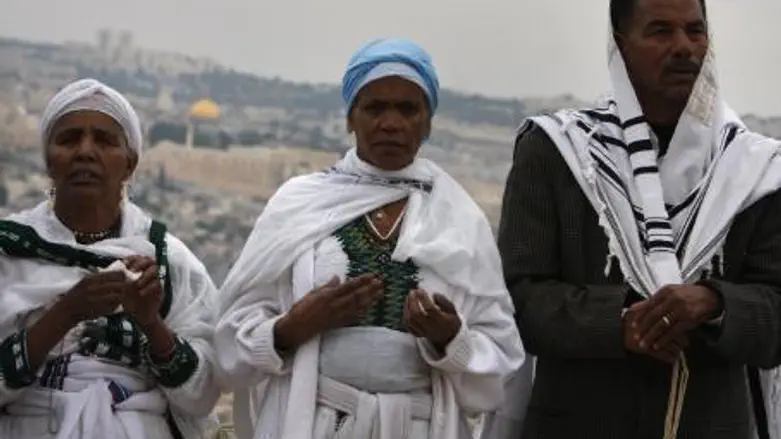
Israel's Ethiopian Jews brought with them a deep love of Zion, willingness to volunteer for the IDF and a strong desire to contribute to Israeli society, despite the many difficulties they encountered in adjusting to their new home. They also brought a new holiday with them, one that has been added to the official calendar of the Jewish state.
Sigd, a holiday celebrated by the Beta Israel Ethiopian Jewish community and almost unknown to the rest of Jewry prior to the group's aliyah to Israel, falls on the 29th of the Hebrew month of Heshvan, the 50th day after the Yom Kippur fast.
The word “Sigd” ( ሰግድ ) is based on the Aramaic word “segida,” which is used to describe a form of bowing in worship to G-d. The holiday is sometimes known as "Mehallela" (ምህልላ), meaning supplication.
Traditionally, the day is split into two: A lengthy service featuring prayers, supplications and fasting, and a festive meal at night.
This year, Cheshvan 29 is on Sabbath, November 22, so the Sigd holiday was moved up to Thursday
Ethiopian Jews, cut off from the rest of the Jewish world and the Oral Law for centuries, interpreted the biblical commandment "And you shall count from the day after the Shabbat… seven full weeks" to mean starting from the day after Yom Kippur, called "Shabbaton" in the Bible – whereas all other Jews count seven full weeks called "Counting the Omer", during the 49 days that separate the Passover and Shavuot holidays.
However, Sigd has other aspects to its observance. It is also a yearly reacceptance of the Torah, modeled after the reacceptance ceremony led by Ezra the Scribe in the month of Heshvan, when the Jews returned from Babylon to build the Second Temple (Nehemiah 9, 1-3).
The 29th of Heshvan is also the day that G-d revealed himself to Moses for the first time on Mount Sinai, in Ethiopian tradition.
Rabbi Shalom Sharon, an alumnus of the Har Etzion Hesder Yeshiva and an Ethiopian immigrant, describes the holiday's observance, summarizing its five central points :
- Remembering the giving of the Torah and our love for it
- Renewing the covenant with G-d as in Ezra's time
- Deepening Jewish identity despite the difficulty of Ethiopian isolation from world Jewry
- Fasting and repentance
- Promoting the community's feeling of unity
The morning prayers include prayers for Jerusalem and requests for forgiveness from G-d and from fellow Jews – much like on Yom Kippur – the difference being that Yom Kippur emphasizes personal atonement and Sigd is intended more for communal introspection and repentance
In Ethiopia, says Rabbi Sharon, members of the community would begin travelling to designated areas days before the holiday. Early on the holiday morning, they would immerse in a ritual bath and put on festive clothing. Led by the Kessim, their religious leaders, they would ascend a high mountain, symbolizing purity and recalling Mount Sinai, to pray. The kes would read aloud from the Orit, the scrolls of the Torah written in Gehz, an esoteric language known to the religious leaders. Other kessim would translate the reading into Amharic or Tigris, the local Ethiopian languages, for the listeners.
The prayers were conducted facing Jerusalem, a mystical, heavenly city in Ethiopian Jewish tradition. The reading including many of the “highlights” of the Torah, including the Ten Commandments, sections describing G-d's blessings and curses and readings from the prophets. The congregants would fall on their faces with palms raised to the heavens and ask for forgiveness for the community's sins.
The prayers closed with the sounding of trumpets, and a procession would come down the mountain, with congregants following the Torah scrolls, singing and dancing on their way. At night, all joined in a communal feast with traditional Ethiopian foods such as the flat, spongy, injera bread.
With most of the Ethiopian Jewish community now in Israel, the central holiday prayers are usually conducted at two sites – the Kotel (Western Wall), and the Armon Hanatziv observation point, where the walls of the Old City are clearly seen. This year, festivities are more local due to the sensitive security situation.
Youth villages, schools and youth groups in neighborhoods with large Ethiopian populations have their own services and festivities.
In Kfar Hanoar Hadati, Kfar Hassidim, for example, it was the custom to awaken the Ethiopian students before dawn, reenacting the Beta Israel's escape from Ethiopia, and the long trek through Sudan to the airplanes waiting to take them to Israel. The youth village's rabbi, Chispin Hesder yeshiva alumnus Rabbi Menachem Kabeda, walked through Sudan alone at the age of 16, as his parents stayed behind to cover for him. He would don white Ethiopian robes and carry the traditional Ethiopian horn, leading the procession of students up to the highest spot in the village, for prayers at dawn. The village's native Israeli yeshiva students would join the procession, as well as the singing and dancing on the way down from the service.
A festive dinner, including the pungent injera, prepared with genuine Ethiopian ingredients by the students and their mothers in the school's kitchen, would end the day. The Ethiopian students took care to warn the Israelis to start with small bites of the highly spiced dishes.
While the holiday is widely celebrated in the Ethiopian community, many of the community's elders have expressed sorrow that the traditions of the “old country” are falling by the wayside, first because the second wave of Ethiopian immigrants, the Falashmura who had converted to Christianity a century ago and then returned to Judaism, did not know about the Sigd and secondly, as with most second generation immigrant populations, many of the young people in the community do not speak Gehz, the priestly language in which most of the prayers are recited. Hebrew versions of the prayers have become more popular in educational institutions.
Sigd was first celebrated in Israel by members of the Ethiopian community in the early 1980s. In February 2008, MK Uri Ariel submitted legislation to the Knesset that would see Sigd established as an Israeli national holiday and the Knesset officially added Sigd to the list of State holidays in July 2008. The law says that Sigd would be marked on the 29th day of Cheshvan in a special assembly organized by the Ministry of Education, or on the Thursday before that date if it falls on Shabbat. Workers are permitted to use the Sigd as a vacation day.
